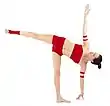Tulasana
Tulasana (Sanskrit: तुलासन; IAST: Tulāsana), Balance pose,[1] Dolasana (Swing pose),[2] Tolasana (Scale pose),[3][4] or Utthita Padmasana (Raised Lotus pose)[5] is a hand-balancing asana in modern yoga as exercise.


Etymology and origins
The name comes from the Sanskrit words tula (तुला) meaning "balance",[6] and asana (आसन, āsana) meaning "posture" or "seat".[7]
The pose is not described in the medieval hatha yoga texts. It appears in the 20th century in Swami Yogesvarananda's 1970 First Steps to Higher Yoga (spelt Tulasana),[8] and in B. K. S. Iyengar's 1966 Light on Yoga (spelt Tolasana).[9]
Description
From Padmasana (lotus position), the practitioner with the palms placed on the floor either side of the hips raises the entire torso and crossed legs using the arms and shoulders.
Benefits
The asana strengthens the back, shoulders, and hips.[10]
See also
- Kukkutasana, another balancing pose with the legs in Padmasana
- Lolasana, a different pendant asana
- List of asanas
References
- Kumar, Brijesh. Enhance Your Sexual Potency. Diamond Pocket Books. pp. 40–. ISBN 978-81-288-0540-0.
- Joshi, K. S. (1 March 2005). Yoga In Daily Life. Orient Paperbacks. p. 116. ISBN 978-81-222-0049-2.
- Swenson, Doug (1 June 2001). Power Yoga for Dummies. John Wiley and Sons. p. 281. ISBN 978-0-7645-5342-4.
- YJ Editors (28 August 2007). "Scale Pose". Yoga Journal.
- Mahatyagi, Raman Das (14 November 2007). Yatan Yoga: A Natural Guide to Health and Harmony. YATAN Ayurvedics. pp. 166–167. ISBN 978-0-9803761-0-4. Retrieved 1 July 2011.
- Goel, Satish. Sex For All. Diamond Pocket Books. p. 69. ISBN 978-81-7182-029-0.
- Sinha, S. C. (1996). Dictionary of Philosophy. Anmol Publications. p. 18. ISBN 978-81-7041-293-9.
- Sjoman, Norman E. (1999) [1996]. The Yoga Tradition of the Mysore Palace. Abhinav Publications. p. 96. ISBN 81-7017-389-2.
- Iyengar, B. K. S. (1979) [1966]. Light on Yoga: Yoga Dipika. Thorsons. p. 134. ISBN 978-1855381667.
- Sachindra Kumar Majumdar (June 1968). Yoga for physical and mental fitness. Stravon Educational Press. p. 54. Retrieved 1 July 2011.
This exercise strengthens the back, shoulders, and hips.
Further reading
- Iyengar, B. K. S. (1 October 2005). Illustrated Light On Yoga. HarperCollins. ISBN 978-81-7223-606-9. Retrieved 9 April 2011.
- Saraswati, Swami Janakananda (1 February 1992). Yoga, Tantra and Meditation in Daily Life. Weiser Books. ISBN 978-0-87728-768-1. Retrieved 11 April 2011.
- Saraswati, Swami Satyananda (1 August 2003). Asana Pranayama Mudra Bandha. Nesma Books India. ISBN 978-81-86336-14-4. Retrieved 9 April 2011.
- Saraswati, Swami Satyananda (January 2004). A Systematic Course in the Ancient Tantric Techniques of Yoga and Kriya. Nesma Books India. ISBN 978-81-85787-08-4. Retrieved 9 April 2011.
_from_Jogapradipika_1830_(detail).jpg.webp)
